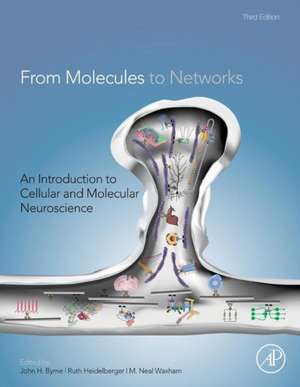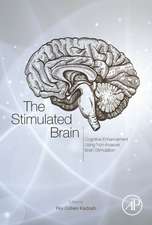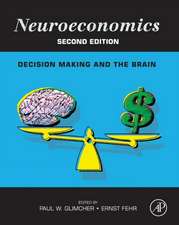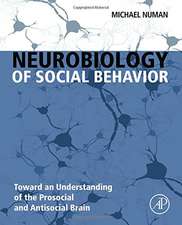From Molecules to Networks: An Introduction to Cellular and Molecular Neuroscience
Editat de John H. Byrne, Ruth Heidelberger, M. Neal Waxhamen Limba Engleză Hardback – 7 iul 2014
All chapters have been thoroughly revised for this third edition to reflect the significant advances of the past five years. The new edition expands on the network aspects of cellular neurobiology by adding new coverage of specific research methods (e.g., patch-clamp electrophysiology, including applications for ion channel function and transmitter release; ligand binding; structural methods such as x-ray crystallography).
Written and edited by leading experts in the field, the third edition completely and comprehensively updates all chapters of this unique textbook and insures that all references to primary research represent the latest results.
- The first treatment of cellular and molecular neuroscience that includes an introduction to mathematical modeling and simulation approaches
- 80% updated and new content
- New Chapter on "Biophysics of Voltage-Gated Ion Channels"
- New Chapter on "Synaptic Plasticity"
- Includes a chapter on the Neurobiology of Disease
- Highly referenced, comprehensive and quantitative
- Full color, professional graphics throughout
- All graphics are available in electronic version for teaching purposes
Preț: 632.30 lei
Preț vechi: 822.75 lei
-23% Nou
Puncte Express: 948
Preț estimativ în valută:
121.03€ • 131.51$ • 101.73£
121.03€ • 131.51$ • 101.73£
Carte tipărită la comandă
Livrare economică 14-28 aprilie
Livrare express 15-21 martie pentru 255.13 lei
Preluare comenzi: 021 569.72.76
Specificații
ISBN-13: 9780123971791
ISBN-10: 0123971799
Pagini: 694
Ilustrații: black & white tables, figures
Dimensiuni: 216 x 276 x 38 mm
Greutate: 2.18 kg
Ediția:3 Rev ed.
Editura: ELSEVIER SCIENCE
ISBN-10: 0123971799
Pagini: 694
Ilustrații: black & white tables, figures
Dimensiuni: 216 x 276 x 38 mm
Greutate: 2.18 kg
Ediția:3 Rev ed.
Editura: ELSEVIER SCIENCE
Public țintă
Graduate and upper undergraduate students Neuroscience, Physiology, Cellular and Molecular Biology, Pharmacology, Psychology, Biochemistry.Cuprins
SECTION I. CELLULAR AND MOLECULAR
1. Cellular Components of Nervous Tissue - Patrick R. Hof, Graham Kidd, Javier DeFelipe, Jean de Vellis, Miguel A. Gama Sosa, Gregory A. Elder and Bruce D. Trapp
2. Subcellular Organization of the Nervous System: Organelles and Their Functions - Scott Brady and Peter Brophy 3. Energy Metabolism in the Brain - Gerald Dienel
4. Intracellular Signaling - Howard Schulman
5. Regulation of Neuronal Gene Expression and Protein Synthesis - Cristina Alberini and Eric Klann
6. Modeling and Analysis of Intracellular Signaling Pathways - Paul D. Smolen, Douglas A. Baxter and John H. Byrne
7. Pharmacology and Biochemistry of Synaptic Transmission: Classical Transmitters - Ariel Y. Deutch and Robert H. Roth
8. Nonclassic Signaling in the Brain - Ariel Y. Deutch, Andrea Giuffrida and James L. Roberts
9. Connexin- and Pannexin-Based Channels in the Nervous System: Gap Junctions and More - Juan C. Sáez and Bruce Nicholson
10. Neurotransmitter Receptors - M. Neal Waxham
11. Molecular Properties of Ion Channels - Jason Tien, Yuh Nung Jan and Lily Yeh Jan
SECTION II. PHYSIOLOGY OF ION CHANNELS, EXCITABLE MEMBRANES AND SYNAPTIC TRANSMISSION
12. Membrane Potential and Action Potential - David A. McCormick
13. Biophysics of Voltage-Gated Ion Channels - Diane Lipscombe
14. Dynamical Properties of Excitable Membranes - Douglas A. Baxter and John H. Byrne
15. Release of Neurotransmitters - Robert S. Zucker, Dimitri M. Kullmann and Pascal S. Kaeser
16. Postsynaptic Potentials and Synaptic Integration - John H. Byrne
17. Cable Properties and Information Processing in Dendrites - Michael Beierlein
SECTION III. INTEGRATION
18. Synaptic Plasticity - Ruth Heidelberger, Harel Shouval, Robert S. Zucker and John H. Byrne
19. Information Processing in Neural Networks - James J. Knierim
20. Learning and Memory: Basic Mechanisms - John H. Byrne, Kevin S. LeBar, Joseph LeDoux, Glenn E. Schafe and Richard F. Thompson
21. Molecular Mechanisms of Neurological Disease - Monica Gireud, Natalie Sirisaengtaksin and Andrew J. Bean
1. Cellular Components of Nervous Tissue - Patrick R. Hof, Graham Kidd, Javier DeFelipe, Jean de Vellis, Miguel A. Gama Sosa, Gregory A. Elder and Bruce D. Trapp
2. Subcellular Organization of the Nervous System: Organelles and Their Functions - Scott Brady and Peter Brophy 3. Energy Metabolism in the Brain - Gerald Dienel
4. Intracellular Signaling - Howard Schulman
5. Regulation of Neuronal Gene Expression and Protein Synthesis - Cristina Alberini and Eric Klann
6. Modeling and Analysis of Intracellular Signaling Pathways - Paul D. Smolen, Douglas A. Baxter and John H. Byrne
7. Pharmacology and Biochemistry of Synaptic Transmission: Classical Transmitters - Ariel Y. Deutch and Robert H. Roth
8. Nonclassic Signaling in the Brain - Ariel Y. Deutch, Andrea Giuffrida and James L. Roberts
9. Connexin- and Pannexin-Based Channels in the Nervous System: Gap Junctions and More - Juan C. Sáez and Bruce Nicholson
10. Neurotransmitter Receptors - M. Neal Waxham
11. Molecular Properties of Ion Channels - Jason Tien, Yuh Nung Jan and Lily Yeh Jan
SECTION II. PHYSIOLOGY OF ION CHANNELS, EXCITABLE MEMBRANES AND SYNAPTIC TRANSMISSION
12. Membrane Potential and Action Potential - David A. McCormick
13. Biophysics of Voltage-Gated Ion Channels - Diane Lipscombe
14. Dynamical Properties of Excitable Membranes - Douglas A. Baxter and John H. Byrne
15. Release of Neurotransmitters - Robert S. Zucker, Dimitri M. Kullmann and Pascal S. Kaeser
16. Postsynaptic Potentials and Synaptic Integration - John H. Byrne
17. Cable Properties and Information Processing in Dendrites - Michael Beierlein
SECTION III. INTEGRATION
18. Synaptic Plasticity - Ruth Heidelberger, Harel Shouval, Robert S. Zucker and John H. Byrne
19. Information Processing in Neural Networks - James J. Knierim
20. Learning and Memory: Basic Mechanisms - John H. Byrne, Kevin S. LeBar, Joseph LeDoux, Glenn E. Schafe and Richard F. Thompson
21. Molecular Mechanisms of Neurological Disease - Monica Gireud, Natalie Sirisaengtaksin and Andrew J. Bean
Recenzii
"Jack Byrne is unique in neuroscience. He is at once a first class experimentalist, bringing to bear a variety of cellular, molecular and imaging approaches to study the mechanisms of learning and memory storage. Here his work has led to a number of penetrating insights, including the first demonstration of operant conditioning in Aplysia. But in addition, what makes Byrne’s thinking and work so unique, is that it combines these experimental techniques with realistic and creative mathematical modeling to determine the extent to which the observed processes and interactions are sufficient to explain the behavior of systems he studies.
This has led to his finding a series of paradigms for enhancing memory storage that are quite remarkable. The Third Edition of From Molecules to Networks is eloquent testimony to this synthesis, the experimental and theoretical and to Jack Byrne’s extraordinary teaching capability, and to his ability to explain science to both students and scientists for which he was recently awarded the National Neuroscience Educational Award." --Eric R. Kandel, MD, Department of Neuroscience, Columbia University, NY, USA
"Meshing together the diverse elements of neuroscience, from molecules to man, is one of the great challenges of brain science. Conveying the integrated story to readers coherently is a major task. This third edition of the now classic From Molecules to Networks text accomplishes all of this with elegance, even better than the preceding two volumes. It will be of inestimable value to student and professional alike." --Soloman H. Snyder, MD, Department of Neuroscience, Johns Hopkins School of Medicine, Baltimore, MD, USA
"Like the previous two editions, this new edition from Byrne, Heidelberger and Waxham is a joy to read: The volume is beautifully produced, the figures make their points perfectly, and the authors of the various chapters are not only experts in their fields, but also have the knack of explaining things clearly. The two best things about this book, though, are that it is completely up-to-date with an emphasis that matches excitement of the field, and that the book’s structure, from molecules to neural circuits, emphasizes organizational principles rather than the more traditional treatment according to a list of neural systems." --Charles F. Stevens, MD, PhD, Professor, The Salk Institute, San Diego, CA, USa
This has led to his finding a series of paradigms for enhancing memory storage that are quite remarkable. The Third Edition of From Molecules to Networks is eloquent testimony to this synthesis, the experimental and theoretical and to Jack Byrne’s extraordinary teaching capability, and to his ability to explain science to both students and scientists for which he was recently awarded the National Neuroscience Educational Award." --Eric R. Kandel, MD, Department of Neuroscience, Columbia University, NY, USA
"Meshing together the diverse elements of neuroscience, from molecules to man, is one of the great challenges of brain science. Conveying the integrated story to readers coherently is a major task. This third edition of the now classic From Molecules to Networks text accomplishes all of this with elegance, even better than the preceding two volumes. It will be of inestimable value to student and professional alike." --Soloman H. Snyder, MD, Department of Neuroscience, Johns Hopkins School of Medicine, Baltimore, MD, USA
"Like the previous two editions, this new edition from Byrne, Heidelberger and Waxham is a joy to read: The volume is beautifully produced, the figures make their points perfectly, and the authors of the various chapters are not only experts in their fields, but also have the knack of explaining things clearly. The two best things about this book, though, are that it is completely up-to-date with an emphasis that matches excitement of the field, and that the book’s structure, from molecules to neural circuits, emphasizes organizational principles rather than the more traditional treatment according to a list of neural systems." --Charles F. Stevens, MD, PhD, Professor, The Salk Institute, San Diego, CA, USa















